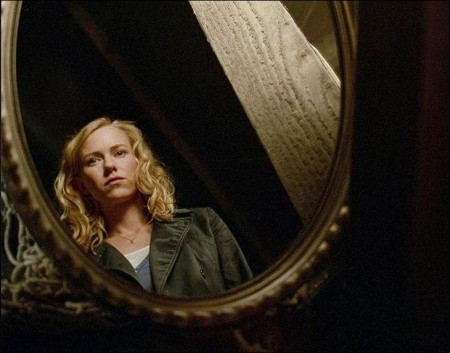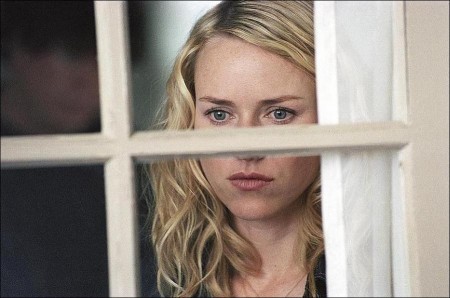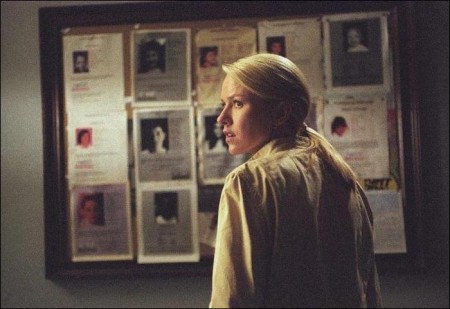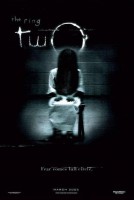Tagline: Fear comes full circle.
Academy Award nominee Naomi Watts (“21 Grams”) reprises the role of investigative reporter Rachel Keller in “The Ring Two,” the sequel to the 2002 horror hit “The Ring.” Hideo Nakata, the director of the original Japanese blockbuster “Ringu” upon which the “The Ring” was based, directed “The Ring Two,” which marks his American film debut.
The story picks up six months after the horrifying events that terrorized Rachel Keller and her son Aidan (David Dorfman) in Seattle. To escape her haunting memories, Rachel takes Aidan and moves to the small coastal community of Astoria, Oregon, to start fresh. However, Rachel’s resolve quickly turns to dread when evidence at a local crime scene-including an unmarked videotape-seems eerily familiar. Rachel realizes that the vengeful Samara is back and more determined than ever to continue her relentless cycle of terror and death.
About the Production
In 1998, Japanese director Hideo Nakata’s original “Ringu” brought J-horror, or Japanese horror-a distinct style of scary movies that rely more on story and character than on heavy special effects and gore-into the forefront of Asian cinema and pop culture. Based on the “Ringu” series of novels by Japanese horror writer Koji Suzuki, the film became the highest grossing film in Japanese cinema history and spawned two sequels, the second of which, “Ringu 2,” was also directed by Nakata.
“Ringu” blended traditional Asian ghost stories and mythology with twentieth century technology, breaking out of the formulaic slash and gore techniques utilized in many of the horror films of the last few decades. Following the international success of “Ringu,” DreamWorks produced “The Ring,” starring Naomi Watts, which became a sleeper hit in the fall of 2002, asmany Americans first discovered and embraced the phenomenon that had been sweeping through Asia.
To direct “The Ring Two,” producers Walter F. Parkes and Laurie MacDonald decided to return to the “source,” choosing Hideo Nakata, to helm the American sequel. The Japanese director marks his American directorial debut with “The Ring Two.” In addition to “Ringu” and “Ringu 2,” Nakata also directed “Kaosu” (ie “Chaos”) and “Honogurai mizu no soko kara” (aka “Dark Water”), both of which have planned American versions being produced.
Nakata’s films have established a reputation for their artful subtlety to conjure up scares, focusing on themes of revenge and evil while overflowing with a foreboding sense of dread. In fact, in Time Magazine’s special April 26, 2004 issue on the “100 Most Influential People in the World,” Nakata was selected in the Artists & Entertainers category for his influential body of Asian ghost movies.
With “The Ring Two,” Nakata has incorporated many of the storytelling techniques and recurring themes established in his earlier work: single mothers, orphaned children, vengeful spirits, water, and the effects of technology on society. In Nakata’s oeuvre, the banal, routine rituals of daily life – the ringing of a phone, the turning of a faucet – are imbued with spine-chilling suspense and trepidation. Normalcy becomes terror.
In 2002, “The Ring” introduced the heroine Rachel Keller and her son, Aidan, who unwittingly become victims to an enigmatic evil that was responsible for the deaths of four teens in a remote mountain cabin. In the film, the spirit of Samara Morgan, a little girl drowned in a well 25 years earlier, was trapped in a netherworld where she uses telepathic abilities to gain access to the living through technology in the form of a videotape. When an unsuspecting victim watches a two-minute montage of surreal images burned onto the tape directly from Samara’s mind, the phone rings, and Samara’s ominously intones, “seven days,” meaning that the viewer has only seven days to live.
After Aidan watches the tape and the seven-day clock begins to tick, Rachel discovers that the secret to saving her son and ending Samara’s viral cycle is to make a copy of the tape. Rachel and Aidan survive, but the tape is still out there.
The sequel brings back the characters of Rachel Keller and her son Aidan, with Naomi Watts reprising the role of Rachel and David Dorfman returning to play Rachel’s son, Aidan Keller. Joining the main cast of “The Ring Two” is another Australian actor, Simon Baker, who American audiences have come to know from his starring role on the CBS series “The Guardian.” Baker plays Max Rourke, the owner and publisher of the local Astoria newspaper, The Daily Astorian, where Rachel now works. At first skeptical of Rachel’s fears, Max is eventually drawn into Samara’s widening circle of terror.
In her search for the true origins of Samara, Rachel meets a mysterious woman named Evelyn, a patient in a Seattle psychiatric hospital. Evelyn, who, with her long dark hair and white dress, resembles an adult Samara, is played by Oscar-winning actress Sissy Spacek. Spacek is legendary to horror fans for her unforgettable performance in the title role of Brian DePalma’s “Carrie,” the 1973 film version of the Stephen King novel.
Elizabeth Perkins, the star of such films as “Big” and “The Flintstones,” plays Dr. Emma Temple, the Astoria Hospital’s staff psychiatrist who is concerned when Aidan is brought in with a baffling case of hypothermia. Emily VanCamp, who for three years has played Amy Abbott on the WB series “Everwood,” appears early in the film as Emily, a teenager who has a traumatizing encounter with the cursed videotape.
Rachel’s nemesis and the villain of the “Ring” series is Samara Morgan, the drowned little girl with the long black matted hair, vengeful stare and haunting white dress. In “The Ring Two,” Samara is seen only in her most malevolently monstrous state, requiring five hours of make-up each day. To play the role, the filmmakers cast Kelly Stables, an actress who had served as one of three Samara doubles for the “evil” Samara in the first “The Ring.”
Six-time Academy Award-winning special effects makeup artist Rick Baker, who created the look of Samara and her victims’ grotesque, distorted death faces in the first “The Ring,” returned with his creative team of make-up artists for “The Ring Two.” Baker was charged with transforming the attractive 20-something Kelly Stables into a young girl who had existed in a dark, dank well for many years. Stables’ long hours in the make-up chair began with her being literally spray painted in a ghostly white pallor.
The make-up team then painted on veins and added make-up appliances before adding Samara’s most notable feature-her long black hair. Two wigs of real human hair were used because one would always get tangled during the many water scenes. Stables also had to wear white prescription contact lenses to make her look blinded Putting on Samara’s signature white gown completed Stables’ transformation into the evil, spirit girl.
Production on “The Ring Two” began May 13, 2004. The first three weeks of filming took place at various locations in and around Los Angeles. The newsroom of the historic former Los Angeles Herald Examiner building in downtown Los Angeles was utilized to portray the interior of The Daily Astorian, the newspaper whose owner, Max Rourke (Simon Baker), hires Rachel Keller (Naomi Watts) as its new editor. The Daily Astorian, the actual newspaper that serves the citizens of Astoria, Oregon, was generous in allowing the production to use their name and likeness in the film.
Other notable Southern California locations utilized in the early weeks of filming included St. Luke’s Hospital in Pasadena, and the Mary Andrews Clark Residence, a circa 1912 historic courtyard apartment complex located in the Mid-Wilshire district that portrays a women’s shelter where Rachel seeks clues to the mysterious early years of Samara, the young girl who was drowned in a well 25 years earlier.
The production then moved to Astoria, Oregon, which was chosen primarily for its often gloomy weather, which, in keeping with the story, lent an ominous tone to the setting. Being built on a peninsula, Astoria’s relationship with water-another major aspect of the film-was also a deciding factor. While based in Astoria, filming took place in the city’s historic downtown core along with many of the surrounding areas and into adjacent Washington State.
For the first three days, filming took place under threatening, rainy skies at St. Mary’s of McGowan, a gray, wood-paneled church built in 1904 along the Columbia River in Chinook, Washington, two miles north of the Astoria Bridge, that links Astoria to Washington State. A grassy clearing adjacent to the church was transformed into the Astoria Farmer’s Market and Antique Fair where Rachel meets Max and some of the colorful local townspeople soon after she and Aidan arrive. Most of the vendors and artisans that manned the rides, games, and artisan booths in the market scene were enlisted from downtown Astoria’s very own Sunday outdoor market, while 250 locals were utilized as background extras.
Rachel and Aidan’s disturbing confrontation with a herd of deer was filmed on the lush, tree-lined forest roads of Fort Stevens State Park. The Oregon coast’s largest state park, it is located in Hammond, Oregon, 10 miles outside of Astoria.
Reminiscent of the horse rampage on the ferry scene from the first “The Ring,” the deer attack reinforces the ill-omened relationship between animals and the evil energy of Samara. The actual choice of deer was very significant to Hideo Nakata and the filmmakers. In Japan, deer play an important role, where in ancient times they were considered sacred animals, divine messengers who were to be bowed to, and today are still protected as national treasures.
The scene is notable as no actual deer were ever used in any part of the filming. One of the film’s most complicated visual effects sequence, the antlered buck were all created and added in post-production through computer-generated imagery produced under the supervision of Rhythm & Hues visual effects supervisor Betsy Paterson and her talented crew of CG animators.
While based in the Pacific Northwest, an extensive second unit crew, led by director Mark Vargo, was on hand to film many of the deer attack sequences and plate shots at Fort Stevens State Park. They also traveled to Seattle to film establishing city skylines, and to the private 50-acre horse ranch in nearby rural Monroe, Washington, that served as the Morgan Ranch in the first “The Ring.”
After completing Astoria location filming, the production returned to Los Angeles and resumed filming on various soundstages at Universal Studios and LA Center Studios.
One of the film’s more complicated scenes, requiring the talents of the special effects and visual effects departments, was in Max’s bathroom where Aidan is locked inside while in the bathtub. Like an anti-gravity water chamber, water coats the ceilings and walls-everywhere but in the bathtub where it belongs-before crashing down in a torrential pool of water, drenching both Rachel and Aidan.
To accomplish the scene, special effects coordinator Peter Chesney and his team built an upside-down bathroom, with about 100 thin wires holding the towels and curtains in place. They then flooded the ceiling in a kind of small pool. That room then segued into the right-side-up set, where they built a series of seven long, skinny dump tanks out of clear polycarbonate so they could light the set through it. They were all on latch relay timers that would sequence from one end of the room to the other, which allowed them to get a progression of water from one end of the room to the other.
For the water-drop sequence, multiple cameras were used, many shooting at a high frame rate to capture the scene in slow motion.
For many, the “The Ring” movies are known as much as for their searing, memorable images as for the stories themselves. The combination of atmospheric and highly stylized visuals and lighting designs, with iconic images such as the well, oval mirrors, static-filled television screens, ladders, insects, pooling water, and craggy trees, have become icons that have been emblazoned in the minds of most horror fans. To many, the look of the film is of equal import to the characters and story itself.
For “The Ring Two,” production designer Jim Bissell, noted for his work on notable films such as “E.T. – The Extraterrestrial,” “Jumanji,” and “Arachnophobia,” derived a blue and green color palette from the Pacific Northwest coastal setting in order to reinforce the film’s recurring water theme and motifs. These tonalities are carried throughout the film, from the locations to the lighting, wardrobe and set dressing.
The director of photography was Gabriel Beristain, best known for his eclectic work on films such as “Caravaggio,” and “Dolores Claiborne.” When it came time to film on location, the fluctuating rainy-to-sunny weather during the two-week shoot in Astoria made it necessary to quickly adjust the lighting scheme, as well as peripheral continuity effects such as the wetting down of roads to match previously filmed shots.
The final days of shooting on “The Ring Two” focused on scenes in and around Samara’s well. The iconic, pixilated well clearing that appears at the beginning of the cursed Ring video was recreated on stage at L.A. Center Studios in Downtown Los Angeles. Production designer Jim Bissell and his design team and greens people filled the entirety of Stage 1 with freshly laid sod and 220 alder trees, surrounded by a giant green screen where the VFX crew would substitute in a steep cliff at the edge of the clearing. The well opening descended into a pit under the stage that allowed Kelly Stables and Naomi Watts to climb up a ladder and into the clearing.
For the climactic interior well chase sequence, multiple interior well sets-both dry and water-bottomed-were erected on two soundstages at Universal Studios. With all the necessary precautions taken, including wire rigs and safety harnesses, Naomi Watts performed most of her own climbing scenes under the guidance of stunt coordinator Keith Campbell.
For the stunt team, preparing the well climbing sequences took a lot of trial and error before Watts was rigged up. For a portion where Samara is seen to erratically spider-walk around the well’s interior, the filmmakers brought in Bonnie Morgan, a professional contortionist who has lent her unique talents to films such as “Minority Report” and “Men in Black 2.” As the stunt Samara, Morgan twisted her limbs to mimic Samara’s creepy, unnatural, movements.
Strange Days
Throughout the filming of “The Ring Two,” a sequence of bizarre Ring-themed occurrences repeatedly affected the production. These incidents sparked many in the cast and crew to surmise that somehow Samara, the film’s evil spirit villain, was somehow escaping the confines of make-believe to break through into reality.
The strange events began May 20, 2004, the “seventh day” of production. Early in the morning, the office staff arrived to discover that the production office had fallen victim to a major flood. Though the reason turned out to be a burst water pipe in the wall, for some the pooling of water-so closely tied to a major theme of the movie-was an omen of possible things to come. The word spread fast and everyone was on alert.
In an effort to forestall any future problems, at the instigation of director Hideo Nakata, a Japanese purification ceremony, conducted by Shinto Minister Reverend Igawa, was conducted at both the production office where the flooding occurred, as well as on set. The goal of the formal ritual was to remove all further misfortune from the production. Members of the crew were welcomed to attend voluntarily at their own discretion.
Even though the production was now officially blessed, nevertheless a string of strange coincidences continued.
While on location, a swarm of thousands of bees suddenly descended on the prop truck, prompting the immediate evacuation of the prop department, before the bees left just as quickly as they arrived.
For no apparent reason, a five-gallon water jug burst open in the production office kitchen, once again flooding the room that had flooded only weeks earlier.
One morning at the lot at Universal Studios, a set costumer stepped out of the parking garage to discover an antlered buck charging across the asphalt in her direction. Though it’s a regular occurrence for deer to descend onto the lot from the surrounding hills, the similarity to the deer attack in the film was uncanny. Principal photography on “The Ring Two” was completed on August 18, 2004.
Production notes provided by DreamWorks Pictures.
The Ring Two
Starring: Naomi Watts, David Dorfman, Simon Baker, Elizabeth Perkins, Sissy Spacek
Directed by: Hideo Nakata
Screenplay by: Ehren Kruger
Release Date: March 18th, 2005
MPAA Rating: PG-13 for violence / terror, disturbing images, thematic elements.
Studio: DreamWorks Pictures
Box Office Totals
Domestic: $76,231,249 (47.2%)
Foreign: $85,220,289 (52.8%)
Total: $161,451,538 (Worldwide)




